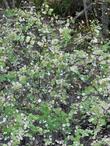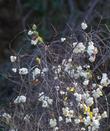Symphoricarpos albus var. laevigatus
Common Snowberry.
Common Snowberry, Symphoricarpos
albus laevigatus is a chin-high, deciduous shrub,
gradually forming a thicket by way of its rhizomes, or underground
stems. Common Snowberry is native to the coast ranges, San Luis Obispo
north to Alaska and has edible, white berries. (Before you get
all excited, they taste like bitter Ivory soap. The Thrashers will eat
them when everything else is eaten, but they have a silly gagged look
as they choke the berries down. Dazed and confused fits in with
everything else around here, though.) The berries rot on the bushes in
good years, in bad they do not even get a chance to ripen. Snowberry
likes sun to shade, some summer water. Hummingbirds visit this in
summer when the small, pinkish flowers are on it. In the fall, on wet
years, or if regularly watered, Snowberry is very beautiful as the bush
becomes overloaded and the branches start to arch from the weight of
all the white berries developing at the tips of the branches This is a
nice, underused plant. If you live in an area of snow it is an effective
large scale groundcover. Its root system is vigorous and deep enough to
hold most banks. Snowberry is stream-side in many locales and would be
an excellent restoration plant. This plant is native down the road from
us where there is a little more moisture. There, the rainfall range
seems to be 25" per year and up. Grows with Rosa californica, and Cornus glabrata here. Soils do not seem to matter as long as
the drainage is fair. This vigorous species can take the interior
conditions a whole lot better than Symphoricarpos
mollis, Creeping Snowberry, but Creeping Snowberry is a better
choice in very coastal areas with shade.
(Synonyms Symphoricarpos racemosus,
Symphoricarpos rivularis, S. rivularis laevigatus, S. albus laevigatus)
Symphoricarpos albus var. laevigatus tolerates sand and seasonal flooding.
Symphoricarpos albus var. laevigatus is great for a bird garden and a butterfly garden.
Foliage of Symphoricarpos albus var. laevigatus has color green-gray and is deciduous.
Flower of Symphoricarpos albus var. laevigatus has color pink.
Communities for Symphoricarpos albus var. laevigatus:Chaparral, Mixed-evergreen Forest, Riparian (rivers & creeks), Yellow Pine Forest and Central Oak Woodland.
| ph: | 6.00 to 8.00 |
|---|---|
| usda: | 4 to 10 |
| height[m]: | 2.00 to 4.00 |
| width[m]: | 4.00 to 6.00 |
| rainfall[cm]: | 63.00 to 219.00 |








 play movie
play movie


